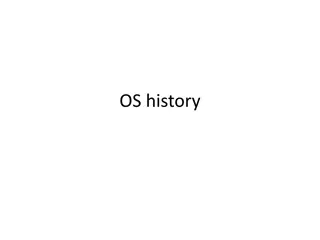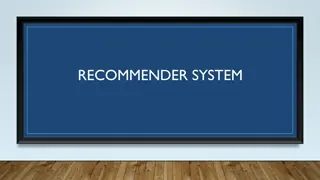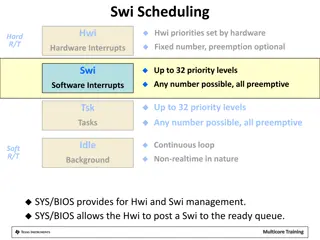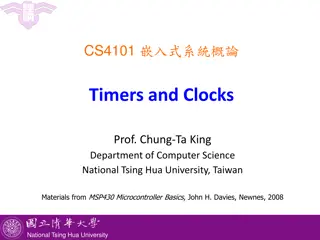Introduction to Real-Time Systems and Real-Time OSes
Real-time systems are defined by the critical nature of timely results, where correctness depends not just on computation but also on when results are produced. Characteristics include timing constraints, deadlines, and different types of tasks categorized based on timing patterns. Understanding soft, firm, and hard deadlines is crucial for managing real-time systems effectively. Challenges include resource optimization, non-CPU concerns, and validation. Utilizing a real-time operating system (RTOS) helps manage real-time deadlines efficiently.
Download Presentation

Please find below an Image/Link to download the presentation.
The content on the website is provided AS IS for your information and personal use only. It may not be sold, licensed, or shared on other websites without obtaining consent from the author.If you encounter any issues during the download, it is possible that the publisher has removed the file from their server.
You are allowed to download the files provided on this website for personal or commercial use, subject to the condition that they are used lawfully. All files are the property of their respective owners.
The content on the website is provided AS IS for your information and personal use only. It may not be sold, licensed, or shared on other websites without obtaining consent from the author.
E N D
Presentation Transcript
EECS 373 An very brief introduction to Real-time systems Real-time OSes Chunks adapted from work by Dr. Fred Kuhns of Washington University and Farhan Hormasji
Announcements Schedule for the remainder of the semester Today, 12/5, (Last lecture) Use remaining lecture time slots to work on projects 12/13 Design Expo 12/15 Project Write-up Due 12/18 Lab Clean-up complete 12/21 Final Exam 1:30-3:30pm in 1010/1018 DOW Please fill out course evaluation online
What is a RTS? What is a Real-Time System? Real-time systems have been defined as: "those systems in which the correctness of the system depends not only on the logical result of the computation, but also on the time at which the results are produced"; J. Stankovic, "Misconceptions About Real-Time Computing," IEEE Computer, 21(10), October 1988.
What is a RTS? Real-Time Characteristics Pretty much your typical embedded system Sensors & actuators all controlled by a processor. The big difference is timing constraints (deadlines). Those tasks can be broken into two categories1 Periodic Tasks: Time-driven and recurring at regular intervals. A car checking for a wall every 0.1 seconds; An air monitoring system grabbing an air sample every 10 seconds. Aperiodic: event-driven That car having to react to a wall it found The loss of network connectivity. 1Sporadic tasks are sometimes also discussed as a third category. They are tasks similar to aperiodic tasks but activated with some known bounded rate. The bounded rate is characterized by a minimum interval of time between two successive activations.
What is a RTS? Soft, Firm and Hard deadlines The instant at which a result is needed is called a deadline. If the result has utility even after the deadline has passed, the deadline is classified as soft, otherwise it is firm. If a catastrophe could result if a firm deadline is missed, the deadline is hard. Examples? Definitions taken from a paper by Kanaka Juvva, not sure who originated them.
What is a RTS? Why is this hard? Three major issues 1. We want to use as cheap ($$, power) a processor as possible. Don t want to overpay 2. There are non-CPU resources to worry about. Say two devices both on an SPI bus. So often can t treat tasks as independent 3. Validation is hard You ve got deadlines you must meet. How do you know you will? Let s discuss that last one a bit more
What is a real-time OS (RTOS)? Well, an OS to manage to meet RT deadlines (duh). While that s all we needwe d like a lot more. After all, we can meet RT deadlines fairly well on the bare metal (no OS) But doing this is time consuming and difficult to get right as the system gets large. We d like something that supports us Deadlines met Interrupts just work Tasks stay out of each others way Device drivers already written (and tested!) for us Portable runs on a huge variety of systems Oh, and nearly no overhead so we can use a small device! That is a small memory and CPU footprint.
Detailed features wed like Deadlines met All the tasks can run and stay out of each other s way. Interrupts are fast So tasks with tight deadlines get service as fast as possible Basically rarely disable interrupts and when doing so only for a short time. Interrupts just work Don t need to worry about saving/restoring registers Which C just generally does for us anyways. Interrupt prioritization easy to set.
Say you have tasks you want to do Consider a car driving around by itself. Has a lot of things it needs to do Read sensors Read camera (yes, it s a sensor, but lots more CPU) Drive motors Make high-level decisions about what actions to take. For your project, you have probably found that integration is the hard part. That is, each task isn t so bad, but getting them all working together sucks.
Detailed features wed like: Tasks stay out of each others way This is actually remarkably hard Clearly we need to worry about CPU utilization issues scheduling algorithm But we also need to worry about memory problems. One task running awry shouldn t take the rest of the system down. So we want to prevent tasks from harming each other This can be key. If we want mission critical systems sharing the CPU with less important things we have to do this. Alternative it to have separate processors. $$$$ The standard way to do this is with page protection. If a process tries to access memory that isn t its own, it fails. Probably a fault. This also makes debugging a LOT easier. This generally requires a lot of overhead. Need some sense of process number/switching Need some kind of MMU in hardware Most microcontrollers lack this So we hit some kind of minimum size. Further reading on page protection (short) http://homepage.cs.uiowa.edu/~jones/security/notes/06.shtml
Hardware interfaces written (and tested!) for us Ideally the RTOS has an interface for all the on-board peripherals. It s a lot easier to call a configure_I2C() function than to read the details of the device specification than to do the memory-mapped work yourself
Portable RTOS runs on many platforms. This is potentially incomputable with the previous slide. It s actually darn hard to do even without peripherals Things like timers change and we certainly need timers.
A specific RTOS: FreeRTOS One of the more popular (and free) RTOSes out there. There are many commercial ones out there with lots of support and features. But FreeRTOS is: Free (as in beer and speech), complete with source Well documented (somewhat free) Easy to use Does the basics well
Tasks Each task is a function that must not return So it s in an infinite loop (just like you d expect in an embedded system really, think Arduino). You inform the scheduler of The task s resource needs (stack space, priority) Any arguments the tasks needs All tasks here must be of void return type and take a single void* as an argument. You cast the pointer as needed to get the argument. I d have preferred var_args, but this makes the common case (one argument) easier (and faster which probably doesn t matter). Code examples mostly from Using the FreeRTOS Real Time Kernel (a pdf book), fair use claimed.
Task creation portBASE_TYPE xTaskCreate( pdTASK_CODE pvTaskCode, const char * const pcName, unsigned short usStackDepth, void *pvParameters, unsigned portBASE_TYPE uxPriority, xTaskHandle *pvCreatedTask ); Create a new task and add it to the list of tasks that are ready to run. xTaskCreate() can only be used to create a task that has unrestricted access to the entire microcontroller memory map. Systems that include MPU support can alternatively create an MPU constrained task using xTaskCreateRestricted(). pvTaskCode: Pointer to the task entry function. Tasks must be implemented to never return (i.e. continuous loop). pcName: A descriptive name for the task. This is mainly used to facilitate debugging. Max length defined by tskMAX_TASK_NAME_LEN default is 16. usStackDepth: The size of the task stack specified as the number of variables the stack can hold - not the number of bytes. For example, if the stack is 16 bits wide and usStackDepth is defined as 100, 200 bytes will be allocated for stack storage. pvParameters: Pointer that will be used as the parameter for the taskbeing created. uxPriority: The priority at which the task should run. Systems that include MPU support can optionally create tasks in a privileged (system) mode by setting bit portPRIVILEGE_BIT of the priority parameter. For example, to create a privileged task at priority 2 the uxPriority parameter should be set to ( 2 | portPRIVILEGE_BIT ). pvCreatedTask: Used to pass back a handle by which the created task can be referenced. pdPASS: If the task was successfully created and added to a ready list, otherwise an error code defined in the file errors.h From the task.h file in FreeRTOS
OK, Ive created a task, now what? Task will run if there are no other tasks of higher priority And if others the same priority will RR. But that begs the question: How do we know if a task wants to do something or not? The previous example gave always wanted to run. Just looping for delay (which we said was bad) Instead should call vTaskDelay(x) Delays current task for X ticks There are a few other APIs for delaying Now we need an under the hood understanding
Task status in FreeRTOS Running Task is actually executing Ready Task is ready to execute but a task of equal or higher priority is Running. Blocked Task is waiting for some event. Time: if a task calls vTaskDelay() it will block until the delay period has expired. Resource: Tasks can also block waiting for queue and semaphore events. Suspended Much like blocked, but not waiting for anything. Tasks will only enter or exit the suspended state when explicitly commanded to do so through the vTaskSuspend() and xTaskResume() API calls respectively. Mostly from http://www.freertos.org/RTOS-task-states.html
Tasks: theres a lot more void vTaskPrioritySet( xTaskHandle pxTask, unsigned uxNewPriority ); Can do all sorts of things Change priority of a task Delete a task Suspend a task (mentioned above) Get priority of a task. Example on the right But we ll stop here Set the priority of any task. pxTask: Handle to the task for which the priority is being set. Passing a NULL handle results in the priority of the calling task being set. uxNewPriority: The priority to which the task will be set.
A RTOS needs to do a lot more Interrupts Including deferred interrupts Memory management Standard I/O interfaces Fast context switch Locks So only one task can use certain resources at a time. FreeRTOS does each of those, some better than others.



























